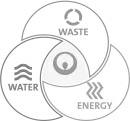The best strategy for driving in bad weather is to avoid it. But if going out is necessary or you get caught in bad conditions once you're already on the road, follow these safe driving tips:
- Make sure your headlights are on.
- Increase your following distance. If you're going slowly because of bad weather, is there really a point to being only two feet behind the car in front of you?
- Slow down. Braking takes longer on slippery roads. The slower you go, the easier it will be for you to stop.
- Use caution near intersections. Never assume that because you have the green light or the right of way that the intersection will be clear. Always scan ahead to spot potential hazards.
- Stay in one lane as much as possible and avoid unnecessary lane changes. Don't go zipping in and out of traffic to pass other drivers. That’s compromising your safety and theirs!
- Keep two hands on the wheel and two eyes on the road at all times.

Veolia is uniquely positioned to service industry, government and commercial entities in improving performance, managing water, waste and energy.
Learn how
WINTER DRIVING
If you live in a cold weather climate, there are a few things that you should do at the beginning of every winter season to make sure you and your vehicle are prepared for whatever conditions winter may bring you on the roadways.
Start by testing your battery and check your antifreeze and windshield wiper fluid levels. Make sure your windshield wipers and headlights are in good working order, and check your tire treads and pressure levels, and adjust accordingly for colder temperatures.
Another tip for winter driving is to have a vehicle emergency kit stored in your vehicle that includes the following items:
- Ice scraper and snow brush
- Bag of sand, salt or cat litter (for traction if you get stuck in snow)
- Warning flares or triangles
- Blankets
- Gloves or mittens
- Flashlight and batteries
- First-aid kit
- Booster cables
- Non-perishable snack foods
- Candle and matches
- Cup in case you need to melt snow for water
If you must travel in snow and ice, keep your car gassed up so that the fuel lines don't freeze. Clear snow completely off the entire car (including the roof) and remember to sweep the taillights and headlights before getting on the road. Once driving, watch out for slow-moving support vehicles like snowplows and sand trucks. Avoid passing these vehicles and try not to get too close. The last thing you need in a snowstorm is a windshield full of sand.
If you do get stranded, stay with your vehicle and call for assistance. Run the heater occasionally to keep warm, but avoid carbon monoxide poisoning by making sure your tailpipe isn't stuffed or blocked with snow or other debris.
No matter what's causing the bad driving conditions, just remember: Don't venture out if you don't have to.
RAINY ROADS
Roads are dirty places. Between tires stirring up gravel and engines dripping oil and other fluids, a lot of oily and slick substances build up on roads. Water brings those oils to the surface, and that's why roads are at their slickest almost immediately after it starts raining.
If you get caught in a slick situation and your car starts gliding or hydroplaning, don't panic or slam on the brakes. Take your foot off the gas and gradually press the brakes, making sure not to turn the steering wheel. To avoid hydroplaning:
- Make sure your tires aren't bald
- Easy does it around turns
- If you can, go around puddles
Many states require drivers to have their headlights on if it's raining. Also, be aware of thunderstorm warnings. If a thunderstorm starts while you're driving and visibility is poor, pull over and wait it out. Don't run the risk of being struck by lightning — stay in your car and pull as far off the road as safely possible.
SUN AND FOG
One of the most vital parts of driving is visibility. Both bright sun and soupy fog can cause limited visibility. To combat that pesky fireball in the sky, always have UV sunglasses somewhere in the car and pop down the visor to further reduce bad glare.
Fog can be a little trickier to handle than bright sunlight. Fog can reduce visibility to less than a quarter mile. Fog can also trick you into thinking you're going slower than you really are, so keep the speed down. When you can't see far ahead, it's hard to see brake lights or traffic signs until you're almost upon them. And just because you can't see doesn't mean that your high beams will improve visibility. In fact, high beams reduce visibility in fog. If your car has fog lamps, use them instead.


